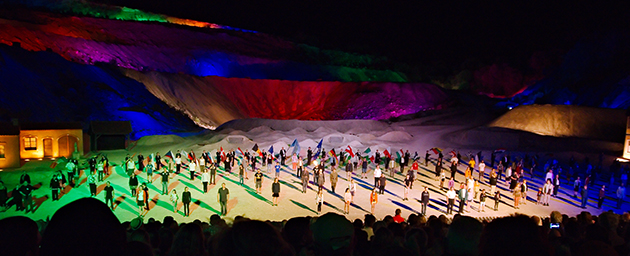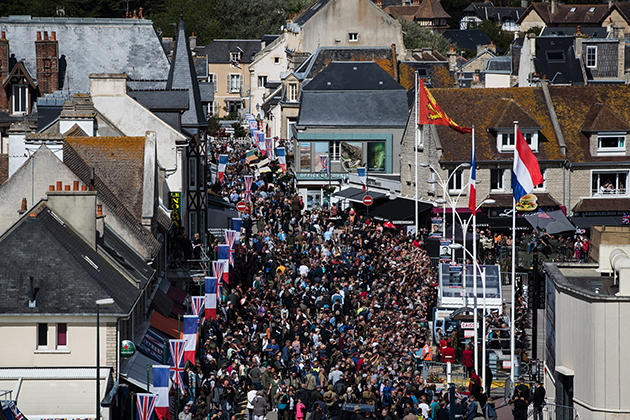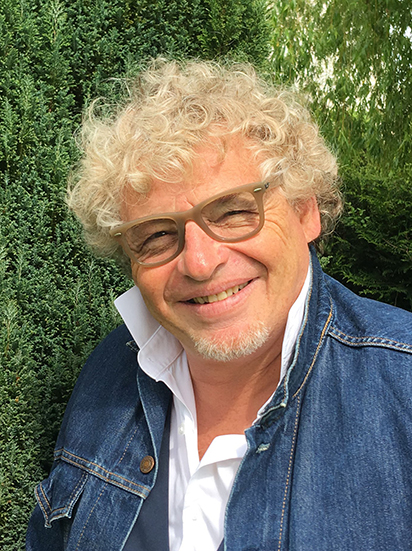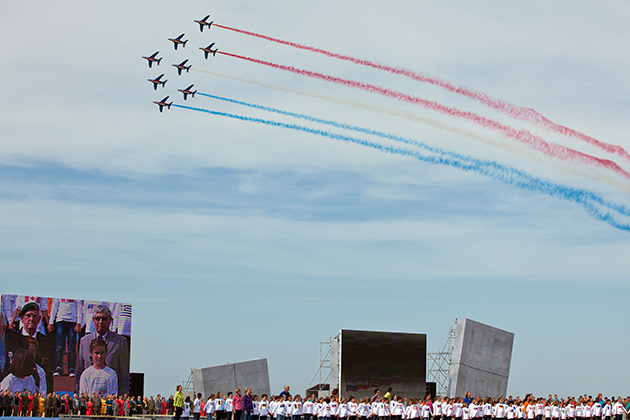Commemoration as performance
The two world wars remain the biggest tragedies of the 20th century, and they are also an inexhaustible source of inspiration to keep history alive and pass it on more effectively. In recent years, historical re-enactments have seen an increasing following, with participants and spectators seeking to “act out” or “witness” history, from a commemorative perspective.
Contemporary historical re-enactments – also known as “living history” – made a conspicuous entry into the “era of commemorations” seen across Europe since the 1980s. Presented as “history made flesh”, historical re-enactments are aimed at a wide audience, who are served up a feast for the senses in the form of spectacular imagery.
As such, re-enactors take seriously their educational role and their capacity to pass on new knowledge about history. Their wide-ranging activities (battle re-enactments, bivouacs, participation in commemorative ceremonies, etc.) often fascinate audiences, in particular their younger members, attentive to such visual demonstrations. In the United States, the American Civil War centenary commemorations, in 1961-65, took on a founding role, after more than 6 000 re-enactors took part in an event to mark the 125th anniversary. In France, the First World War centenary, in turn, saw a large-scale mobilisation of re-enactment societies, most notably in August 2018 at the Mémorial de Verdun, in association with the French centenary commission, the Mission du Centenaire, which involved nearly 1 000 participants from 18 different countries, with their costumes and equipment.
Historical re-enactment, 2018 – activities © Mémorial de Verdun/Jean-Marie Mangeot
Performances promoting peace
The displays put on by these enthusiasts and their growing presence at the heart of current commemorative strategies lead us to think about commemoration itself. More often than not, the choice of commemorating an event comes down to small groups of enthusiasts, battle re-enactment societies who show a desire to construct forms of sociability and to cater for the need for identity and identification. These commemorative usages fulfil perfectly the three key functions of the commemorative act: to remember an event, to bring it up to date and to enable a refounding of the community concerned, as well as getting people involved.
The issues seen in the 21st century and that apply to the great tragedies of the two world wars or the wars of decolonisation have given rise to increasing numbers of commemorative events, mainly organised by veterans, and to the erection on French soil of memorials that evoke the horrors of war, massacres or genocides (e.g. the Historial de la Grande Guerre in Péronne and the Mémorial de Caen). Some contemporary shows tell tragic stories that promote future peace and are situated in what are often key remembrance spaces. That is the case of an organisation in Pressins, Isère, which in 2014 undertook a life-size re-enactment of scenes from the First World War. In this Isère village, far from the front line, three trenches were dug, military posts installed and a historical display scheduled to mark the centenary. So came into being the Regards de Mémoire project – in conjunction with an exhibition on the First World War sponsored by the Ministry of Defence – reconstructing day-to-day life in the trenches with support from the Mission du Centenaire and getting local volunteers involved in a historical re-enactment of the wartime fate of a group of brothers, the frères Joseph. The organisers started from what was, above all, a universal premise: “Does one need war to be a man? (…) Look at the “Gueules Cassées” of the First World War, with their horrifically disfigured faces. Look at the millions of women and children mutilated by anti-personnel mines (that weapon of the cowardly), raped, murdered or massacred, throughout the world, from Africa to Europe, Asia to South America. Look, then say once more that war is beautiful! Dare to say it! (...) The idea behind this show is for us to reflect on war and to understand that armies, while still necessary today, should serve above all peaceful purposes. This show is dedicated to the millions of men struck down in the prime of life, the millions of anonymous heroes who died in vain, for so little, for a slice of French or German soil, soil which has today become European soil.” The site is entirely devoted to the goal of conveying that message to the younger generation, for whom the memory of war should be transformed into a pacifist ethos: “This show is dedicated to the young people of today and tomorrow, to tell them loud and clear that war has never been the answer and that real courage lies in the tireless quest for peace.” Thus the educational aspect of the show becomes a key to its understanding, while the dramaturgy plays on an emotional level to impact the audience’s sensibility.
An experience centred on the lives of the poilus
That is the message conveyed, too, by the unmissable show Des Flammes à la Lumière, staged in 1996 to mark the 80th anniversary of the Battle of Verdun, in the lime-kiln quarries of Haudainville. The project’s website presents the show as the biggest in Europe about the First World War, and an overwhelming success with over 530 000 spectators. The son et lumiére show combines an audiovisual immersion in the thick of the fighting with a message of peace and remembrance: “Lest we forget... That is the feat achieved by Des Flammes à la Lumière. To bring to life the troubled period of the Battle of Verdun, from the Belle Époque to the war in the trenches, the horrific winters in the mud and cold, Germans and Frenchmen in the same boat, the hardships on the home front too, the evacuation of civilians, and finally the Armistice: a return to peace and hope reborn.” The term “remembrance” applies to these periods as though collective mourning were not yet over. What we take away from it is what life was like for the men in the trenches, whatever their nationality, in a Europe today united by a Franco-German alliance. An experience more centred on the lives of the poilus, as the French soldiers of the First World War were affectionately nicknamed, is offered by Épernay-based group Le Poilu de la Marne, founded in 1991. As well as re-enactments, its members take part in parades and give exhibitions from a large collection of uniforms, weaponry and documents, and participate in short films and TV programmes, appearances worthy of attention from historians. They also take upon themselves a “duty to remember”, a term originally adopted by survivors of the Holocaust and now in widespread use to apply to the great tragedies of history. Unlike the shows mentioned previously, which include the participation of women – for instance, caring for the wounded or deciding their own destinies away from the front – this group highlights the role of these soldiers, emblematic of the brutality of war by their suffering, subjected to an experience that is hard to put into words. For the army open days in the garrison town of Mourmelon, Le Poilu de la Marne produced a reconstruction of a First World War camp as a kind of “mise en abyme”. Finally, in 2019, near Toulouse, a group staged a re-enactment of the demobilisation of troops following the 1918 armistice. On the eve of the Armistice Day commemorations, enthusiasts re-enacted scenes of demobilisation in Montespan, southern Haute-Garonne, a unique way of paying tribute to the soldiers of the Great War. Hundreds of miles from the front, history enthusiasts once again reproduced life-size scenes of demobilisation of the troops at the end of the First World War.

Des Flammes à la Lumière, performed on 11 July 2015 in the quarries of Haudainville, Verdun. © Frédéric Bisson
To be precise, on 10 November 2019, on the eve of the Armistice Day commemorations, three historical re-enactment societies – Les Diables Bruns, Les Poilus de Vaucluse and Les Oies Sauvages – reproduced the entire process of demobilisation which soldiers went through at the end of the war: troop census, treatment of the wounded in a field hospital, religious services, demobbing, etc.
The birth of a market
Military history enthusiasts (collectors of figurines, badges, weapons, sometimes even vehicles) come in their droves to the re-enactments, and Militaria is one of the most popular reviews for its reports on these life-size retellings of war. These commemorative historical displays are dependent on public funding grants for tourism and heritage development, or on sponsors who, in exchange, gain visibility in the local cultural events programme. The vast majority of these activities are derived from voluntary action, in accordance with the Law of 1901, which mobilises volunteers and entertainment workers in groups ranging from a dozen to several hundred. Voluntary sector involvement constitutes a significant feature of recent developments in society in a wide variety of areas, and history re-enactment societies are no different. In this context, Christian Bromberger has succeeded in reviving the idea of “passion”: “Passion is no longer conceived and perceived as a phenomenon to which one is subjected, a deterioration of the will, but on the contrary as its expression, as a manifestation of creative freedom, a constructive choice, ratified by the conscience, that gives meaning to an authentic existence.” Meanwhile, the performance form at the heart of the re-enactments, involving a succession of historical tableaux and the recreation of costumes or objects, results in a dramaturgy, a type of narrative or a way of viewing the past that differ greatly from those proposed by more academic bodies, in scattered centres, made legitimate by these new history mediators. Finally, re-enactments and displays require strong economic organisation to manage the groups and projects. A parallel market has thus emerged to cater for the growing demand for specialist items for these re-enactments, available for purchase online. The list of what you can buy is vast: weaponry, armour and protection, belts and buckles, shoes and skates, illuminations, cases, bags and pouches, furniture and accessories.

Visitors and re-enactors make their way through the streets of Arromanches (Normandy) to celebrate the 75th anniversary of the D-Day landings, 6 June 2019. © Joël Saget/AFP
In this way, the wars of the 20th century are revisited with a view to minimising, for commemorative and pacifist purposes, the new alliances or the absurdity of the conflicts that go beyond the combatants and the civilian population. These performances are presented as a form of collective mourning at the traumas of the 20th century or contemporary remembrance abuses. The staged history becomes a source to draw on for a change in shared values, where knowledge diversity, entertainment and conviviality combine. As this small number of examples have shown: the actors take over the public arena, carrying in their wake a whole population (volunteer actors and spectators), and the events thus promote a return to community gatherings; the actors publicise a fictional story to be shared and forge a shared memory of the past, at local level. Therefore, if the traditional forms of commemoration can seem ossified and repetitive, this kind of re-enactment or performance breaks the ceremonial monotony and enables social ties to be re-established, when those who actually took part in the events are no longer with us. The elected representatives with responsibility for these commemorations have a “moral duty” to support the ceremonies, by offering distinctive or innovative cultural formats and scenographic choices that contribute to commemorative diversity. More festive and entertaining, these commemorations involving the performing arts are legitimated by the need to produce post-school remembrance exercises whose success is measured by the enthusiasm of the spectators.
Maryline Crivello - Historian, lecturer at Aix-Marseille University and researcher at UMR TELEMMe (AMU-CNRS)
Spotlight on 6 June 2014
Yvan Hinnemann has taken part in many events that have marked the lives of French people, such as the bicentenary of the French Revolution or the official opening of the Stade de France. In 2014, he directed the display for the international ceremony marking the 70th anniversary of the D-Day landings.

Yvan Hinnemann
You directed the show for the international ceremony of 6 June 2014 in Ouistreham. What made you choose to respond to the call for proposals?
That commemoration was an appointment with the living history of humanity, with many surviving veterans still with us, who lived through those historic days. Getting involved in the ceremony meant showing respect for the historical events, humility towards the women and men of that time who still attend the different tributes and, lastly, striking a political and historical balance for the period, represented by the presence of all the heads of State, kings and queens, of all the nations that deployed their armed forces on the fronts of Normandy, Europe and the world.
This combination of factors made the call for proposals an exciting prospect, since it comprised history, scenography, staging and protocol, with the main goal of passing on the memory of the events to the younger generation.
These were the arguments that made us accept without difficulty the five-month proposal process, as lengthy as the planning of the commemoration itself.
How did you approach the scenography of an event on such a scale?
A huge number of parameters have to be taken into account. You have to proceed with restraint, analyse as necessary, endlessly check the historical accuracy of the message, force yourself to refine what is ostentatious or superfluous, to come up with a well-balanced written scenario that becomes the narrative thread. We set up a creative team, comprising a documentary director, a TV director, a set designer, a choreographer, a sound engineer, costume designers and a pyrotechnics designer, who were in charge of overseeing the staging of the event.
We kept in mind throughout that this had to be a “global” tribute, because it had to speak to a billion viewers, not just the 20 000 spectators and veterans attending in person. We had to find a universal language, so choreography and music became our chosen forms of expression for the scenario sequences.
Imbued with sensibility and emotion, music and dance allow events to be evoked without resorting to historical re-enactment, an exercise that would have undermined their credibility before spectators who had witnessed and participated in those same historical events. As an additional language element, we incorporated the TV production into the process, so that production and staging were a seamless whole.
The history would be presented by means of big screens in the form of Atlantic Wall bunkers, displaying archive film footage in a perfect chronology, so that the ceremony did not stray from the tribute it was supposed to be paying. From another point of view, the sublime vastness of Ouistreham beach, a line joining earth and sky, was totally turned towards the world. It was the site that made the rules and inspired the décor. By laying out a map of Europe on the ground, we could no longer stray from the overarching image of the combined forces required to rid ourselves of our oppressors.

International ceremony marking the 70th anniversary of the Normandy
Previously, commemorative ceremonies followed a set ceremonial order. Why does there now seem to be a tendency towards “spectacularisation”? What meaning does this staging give to the commemorations?
I remain reserved on this question. Some commemorations have rituals that must be respected, in which it is not necessary to add artistic elements; it is all about striking the right balance (ceremonies in honour of service personnel killed in operations, for example). Commemorations that have recourse to staged settings often do so for key episodes of history. It is a modern, open book, which uses new technologies (video, giant projections, etc.) or stagings to tell various chapters or the stories of personalities.
It is another form of expression to encourage young people to stay in touch with the historical and republican rituals that bind a nation together. Through visual and media appeal, it can be hoped to prolong the duty to remember.

